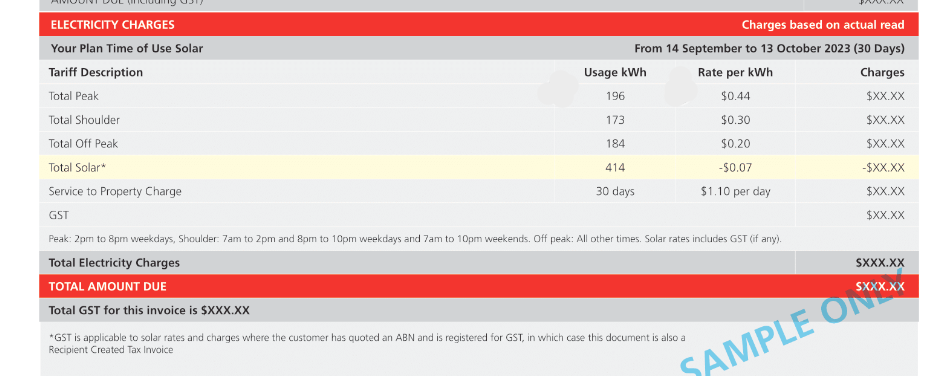Reference prices in south-east QLD, NSW, SA and Victoria will change from July 1, 2025.
We’re working to ensure the latest product information is displayed as soon as it’s made available to us by providers.
Please confirm plan information with the provider before making a decision.
KEY POINTS
- A single rate tariff refers to a fixed price for electricity unaffected by the time of day it is used. A time of use tariff refers to different prices for electricity depending on when it is consumed (e.g. off-peak vs peak times).
- Peak and off-peak period electricity rates are only applicable on a time of use tariff.
- Single rate tariffs are cost-efficient for customers who consume more energy during peak periods, while time of use tariffs can help customers who consume less energy during peak periods save on their energy bills.
On this page:
- How to check when electricity rates are peak and off-peak
- Peak and off-peak electricity times
- AGL peak and off-peak electricity times
- EnergyAustralia peak and off-peak electricity times
- Origin peak and off-peak electricity times
- What does ‘peak usage’ mean?
- Peak vs off-peak electricity prices
- Peak vs off-peak electricity times in NSW, QLD, VIC and SA
- Should I use peak and off-peak electricity rates?
Peak and off-peak electricity times
Peak, off-peak and shoulder electricity usage times vary between energy retailers and states.
But as a general guide, we have listed times for AGL, Origin and EnergyAustralia below.
Please note that these time periods may change in the future which is why it’s always best to refer to the energy price fact sheets.
If you’re with a different retailer, you can check their peak and off-peak usage times and charges by reviewing their energy price fact sheets.
AGL peak and off-peak electricity times
 Peak and off-peak electricity times from AGL vary between states:
Peak and off-peak electricity times from AGL vary between states:
Victoria (Citipower)
- Peak: 3pm to 9pm everyday
- Shoulder: Not applicable
- Off-peak: 9pm to 12am and 12am to 3pm everyday
New South Wales (Ausgrid)
- Peak: 2pm to 8pm on weekdays excluding public holidays
- Shoulder: 7am to 2pm and 8pm to 10pm on weekdays, 10pm – 7am on weekends
- Off-peak: 10pm to 7am everyday
South East Queensland (Energex)
- Peak: 4pm to 9pm everyday
- Shoulder: 9pm to 12am, 12am to 9pm every day
- Off-peak: 9am to 4pm everyday
South Australia (SA Power Networks)
- Peak: 6am to 10am and 3pm to 1am every day
- Shoulder: 10am to 3pm every day
- Off-peak: 1am to 6am everyday
AGL single rate pricing
Being on a flexible pricing tariff naturally means you’ll pay different electricity rates depending on the time of day you use power.
But if you’d rather pay the same price regardless of the time of day you use energy, listed below are AGL’s current single rate electricity plans.
See our comprehensive breakdown of AGL’s offers for more information, or use our comparison tool above for the most specific quotes in your area.
Here are the AGL Energy plans on our database for NSW. These are products from a referral partner†. These costs are based on the Ausgrid network in Sydney but prices may vary depending on your circumstances. This comparison assumes general energy usage of 3,900kWh/year for a residential customer on a single rate tariff. Please use our comparison tool for a specific comparison in your area. Our database may not cover all deals in your area. As always, check all details of any plan directly with the retailer before making a purchase decision.
Here are the AGL Energy plans on our database for Victoria. These are products from a referral partner†. These costs are based on the Citipower network in Melbourne but prices may vary depending on your circumstances. This comparison assumes general energy usage of 4,000kWh/year for a residential customer on a single rate tariff. Please use our comparison tool for a specific comparison in your area. Our database may not cover all deals in your area. As always, check all details of any plan directly with the retailer before making a purchase decision.
Here are the AGL Energy plans on our database for SE QLD. These are products from a referral partner†. These costs are based on the Energex energy network in Brisbane but prices may vary depending on your circumstances. This comparison assumes general energy usage of 4,600kWh/year for a residential customer on a single rate tariff. Please use our comparison tool for a specific comparison in your area. Our database may not cover all deals in your area. As always, check all details of any plan directly with the retailer before making a purchase decision.
Here are the AGL Energy plans on our database for South Australia. These are products from a referral partner†. These costs are based on the SA Power network in Adelaide but prices may vary depending on your circumstances. This comparison assumes general energy usage of 4,000kWh/year for a residential customer on a single rate tariff. Please use our comparison tool for a specific comparison in your area. Our database may not cover all deals in your area. As always, check all details of any plan directly with the retailer before making a purchase decision.
EnergyAustralia peak and off-peak electricity times

Here are the peak, off-peak and shoulder periods offered by EnergyAustralia on a time of use tariff in each state.
Victoria (Citipower)
- Peak: 3pm to 9pm every day
- Shoulder: Not applicable
- Off-peak: 9pm to 12am and 12am to 3pm everyday
New South Wales (Ausgrid)
In New South Wales, EnergyAustralia goes a step further and offers peak and off-peak electricity rates which differ between the summer and winter months. This is known as a seasonal time-of-use tariff.
Summer (1 Nov to 31 Mar):
- Peak: 2pm to 8pm on weekdays
- Shoulder: 7am to 2pm and 8pm to 10pm on weekdays, 7am to 10pm weekends
- Off-peak: 10pm to 7am everyday
Winter (1 Jun to 31 Aug):
- Peak: 5pm to 9pm on weekdays
- Shoulder: 7am to 5pm, 9pm to 10pm on weekdays, 7am to 10pm on weekends
- Off-peak: 10pm to 7am everyday
Non Summer/Non Winter (1 Apr to 31 May and 1 Sep to 31 Oct):
- Peak: Not applicable
- Shoulder: 7am to 10 pm everyday
- Off-peak: 10pm to 7am everyday
South East Queensland (Energex)
EnergyAustralia doesn’t currently offer a time of use tariff to its South East Queensland customers. It does however offer a demand tariff, which has a peak time from 4pm to 9pm.
South Australia (SA Power Networks)
- Peak: 12am to 1am, 6am to 10am and 3pm to 12am
- Shoulder: 10am to 3pm every day
- Off-peak: 1am to 6am everyday
While the times mentioned above are indicative, be aware that off-peak and peak hours can vary marginally between the different distribution networks in Victoria and New South Wales.
EnergyAustralia single rate pricing
If you’d rather pay the same price for power no matter the time of day, below we have listed EnergyAustralia’s current plans and estimated annual costs.
See our comprehensive breakdown of EnergyAustralia’s offers for more information, or use our comparison tool above for specific quotes in your area.
Here are the EnergyAustralia plans on our database for NSW. These are products from referral partners†. These costs are based on the Ausgrid network in Sydney but prices may vary depending on your circumstances. This comparison assumes general energy usage of 3900kWh/year for a residential customer on a single rate tariff. Please use our comparison tool for a specific comparison in your area. Our database may not cover all deals in your area. As always, check all details of any plan directly with the retailer before making a purchase decision.
Here are the EnergyAustralia plans on our database for Victoria. These are products from referral partners†. These costs are based on the Citipower network in Melbourne but prices may vary depending on your circumstances. This comparison assumes general energy usage of 4000kWh/year for a residential customer on a single rate tariff. Please use our comparison tool for a specific comparison in your area. Our database may not cover all deals in your area. As always, check all details of any plan directly with the retailer before making a purchase decision.
Here are the EnergyAustralia plans on our database for SE QLD. These are products from referral partners†. These costs are based on the Energex network in Brisbane but prices may vary depending on your circumstances. This comparison assumes general energy usage of 4600kWh/year for a residential customer on a single rate tariff. Please use our comparison tool for a specific comparison in your area. Our database may not cover all deals in your area. As always, check all details of any plan directly with the retailer before making a purchase decision.
Here are the EnergyAustralia plans on our database for South Australia. These are products from referral partners†. These costs are based on the SA Power network in Adelaide but prices may vary depending on your circumstances. This comparison assumes general energy usage of 4000kWh/year for a residential customer on a single rate tariff. Please use our comparison tool for a specific comparison in your area. Our database may not cover all deals in your area. As always, check all details of any plan directly with the retailer before making a purchase decision.
Origin peak and off-peak electricity times

Peak and off-peak electricity times from Origin are as follows:
Victoria (Citipower)
- Peak: 3pm to 9pm every day
- Shoulder: Not applicable
- Off-peak: 12am to 3pm; Every day, 9pm to 12am
Please keep in mind that these rates are based on the defaulted two-period time of use tariff in Victoria. Origin also offers a five-day time of use tariff or flexible pricing tariff which comes with varying peak and off-peak times to those listed above.
New South Wales (Ausgrid)
1 Nov to 31 Mar:
- Peak: 2pm to 8pm on weekdays
- Shoulder: 7am to 2pm and 8pm to 10pm weekdays, 7am to 10pm on weekends
- Off-peak: 10pm to 7am every day
1 Apr-31 May & 1 Sep-31 Oct:
- Peak: Not applicable
- Shoulder: 7am to 10pm every day
- Off-peak: 10pm to 7am every day
1 Jun to 31 Aug:
- Peak: 5pm to 9pm on weekdays
- Shoulder: 7am to 5pm and 9pm to 10pm on weekdays, 7am to 10pm on weekends
- Off-peak: 10pm to 7am every day
Please note, the above rates refer to Origin’s seasonal time of use tariff.
South East Queensland (Energex)
- Peak: 4pm to 8pm on weekdays
- Shoulder: 7am to 4pm and 8pm to 10pm weekdays, 7am to 10pm on weekends
- Off-peak: 10pm to 7am everyday
South Australia (SA Power Networks)
- Peak: 6am to 10am, 3pm to 1am everyday
- Shoulder: 10am to 3pm everyday
- Off-peak: 1am to 6am everyday
Origin single rate pricing
Time of use electricity tariffs are not for everyone, so if you’d rather pay the same prices every hour of the day, below are listed Origin’s electricity plans with estimated annual costs.
See our comprehensive breakdown of Origin’s offers for more information, or use our comparison tool above for a specific quote in your area.
Origin Energy Prices NSW
Here are the Origin Energy plans on our database for NSW. These are products from a referral partner†. These costs are based on the Ausgrid network in Sydney but prices may vary depending on your circumstances. This comparison assumes general energy usage of 3900kWh/year for a residential customer on a single rate tariff. Please use our comparison tool for a specific comparison in your area. Our database may not cover all deals in your area. As always, check all details of any plan directly with the retailer before making a purchase decision.
Origin Energy Prices VIC
Here are the Origin Energy plans on our database for Victoria. These are products from a referral partner†. These costs are based on the Citipower network in Melbourne but prices may vary depending on your circumstances. This comparison assumes general energy usage of 4000kWh/year for a residential customer on a single rate tariff. Please use our comparison tool for a specific comparison in your area. Our database may not cover all deals in your area. As always, check all details of any plan directly with the retailer before making a purchase decision.
Origin Energy Prices QLD
Here are the Origin Energy plans on our database for SE QLD. These are products from a referral partner†. These costs are based on the Energex network in Brisbane but prices may vary depending on your circumstances. This comparison assumes general energy usage of 4600kWh/year for a residential customer on a single rate tariff. Please use our comparison tool for a specific comparison in your area. Our database may not cover all deals in your area. As always, check all details of any plan directly with the retailer before making a purchase decision.
Origin Energy Prices SA
Here are the Origin Energy plans on our database for South Australia. These are products from a referral partner†. These costs are based on the SA Power network in Adelaide but prices may vary depending on your circumstances. This comparison assumes general energy usage of 4000kWh/year for a residential customer on a single rate tariff. Please use our comparison tool for a specific comparison in your area. Our database may not cover all deals in your area. As always, check all details of any plan directly with the retailer before making a purchase decision.
What does ‘peak usage’ mean?
You will see the term ‘peak usage’ on electricity bills, but this can mean different things to different customers, depending on the type of energy tariff they are on.
- A single rate tariff charges the same unit price for electricity regardless of the time of day it is used. However, energy retailers still refer to these prices as ‘peak usage’. This is especially true if you are on a controlled load tariff, where an energy-intensive appliance such as hot water heating or your pool pump is metered at a reduced rate
- A time of use tariff charges different prices for electricity depending on what time of day it is used. In this scenario, ‘peak usage’ reflects the amount of energy used during electricity peak hours
Peak usage information alongside all other cost details – including other tariffs – can be found by reading your electricity bill.
In the case of a household on a single rate tariff, the peak usage component will simply reflect all energy usage (with the exception of a controlled load, if applicable).
Customers on a time of use tariff can locate their peak usage costs next to their off-peak costs, ‘shoulder’ costs (the time between peak and off-peak hours, if applicable) and daily supply charges.
The below example is an Origin bill for a household with a time of use tariff.

How to check when electricity rates are peak and off-peak
If you’re not sure which tariff you’re on, check your electricity bill or contact your energy retailer.
Currently, the vast majority of Australian households are on a single rate tariff, but you should be aware of the type of plan you’re on before adjusting your electricity habits.
Customers on a single rate tariff could incorrectly be thinking they are paying different rates for power throughout the day and therefore delaying their consumption to no benefit.
Peak and off-peak electricity rates are only applicable for Aussies signed up to a ‘time of use’ or ‘flexible pricing’ tariff. To do this, a smart meter must be installed on their property.
Electricity users will only be on a time of use tariff if they have discussed the option with their energy retailer and believe it is financially beneficial (i.e. generally using more electricity during the day or late at night, rather than the early evening).
Because there’s no guarantee that a time of use tariff is better than a single rate tariff in your situation, it’s important to consider your usage habits before switching tariff types.
Compare energy deals
Here are some sponsored deals from the retailers on our database that include a link to the retailer’s website for further details. These are products from referral partners†. These costs are based on the Ausgrid energy network in Sydney but prices may vary depending on your circumstances. This comparison assumes general energy usage of 3900kWh/year for a residential customer on a single rate tariff. Please use our comparison tool for a specific comparison in your area and to see other products in our database that may be available. Our database may not cover all deals in your area. As always, check all details of any plan directly with the retailer before making a purchase decision.
|
12% Less than reference price |
$1,491 Price/year (estimated) |
Go to Site |
Here are some sponsored deals from the retailers on our database that include a link to the retailer’s website for further details. These are products from referral partners†. These costs are based on the Citipower network in Melbourne but prices may vary depending on your circumstances. This comparison assumes general energy usage of 4000kWh/year for a residential customer on a single rate tariff. Please use our comparison tool for a specific comparison in your area and to see other products in our database that may be available. Our database may not cover all deals in your area. As always, check all details of any plan directly with the retailer before making a purchase decision.
 |
|
11% Less than VDO |
$1,200 Price/year (estimated) |
Go to Site |
Here are some sponsored deals from the retailers on our database that include a link to the retailer’s website for further details. These are products from our referral partners†. These costs are based on the Energex network in Brisbane but prices may vary depending on your circumstances. This comparison assumes general energy usage of 4600kWh/year for a residential customer on a single rate tariff. Please use our comparison tool for a specific comparison in your area and to see other products in our database that may be available. Our database may not cover all deals in your area. As always, check all details of any plan directly with the retailer before making a purchase decision.
 |
|
14% Less than reference price |
$1,681 Price/year (estimated) |
Go to Site |
Here are some sponsored deals from the retailers on our database that include a link to the retailer’s website for further details. These are products from our referral partners†. These costs are based on the SA Power network in Adelaide but prices may vary depending on your circumstances. This comparison assumes general energy usage of 4011kWh/year for a residential customer on a single rate tariff. Please use our comparison tool for a specific comparison in your area and to see other products in our database that may be available. Our database may not cover all deals in your area. As always, check all details of any plan directly with the retailer before making a purchase decision.
 |
|
6% Less than reference price |
$2,036 Price/year (estimated) |
Go to Site |
Peak vs off-peak electricity prices
Typically, peak electricity prices cost upwards of 40c per kilowatt hour (kWh), with some retailers charging as much as 60c/kWh in some cases.
Off-peak electricity prices generally tend to sit around the 15c-25c/kWh mark depending on location, although some retailers have been known to charge under 10c/kWh before for either shoulder or off-peak times.
There is a dramatic difference in peak and off-peak prices. If you are signed up for a time of use tariff, shifting a good percentage of your daily energy usage to off-peak times would be a smart way to reduce your energy bills. If you face trouble delaying the bulk of your energy usage to off-peak hours – you could be better off sticking with ta single rate tariff, whereby you’ll pay the same price for power at all times and reduce your chances of bill shock.
For a time of use tariff to work out cheaper than a single rate tariff, you will likely need to shift about a third of your daily energy requirements to off-peak hours (generally 10pm to 7am).
You might also be interested in:
Peak vs off-peak electricity times in NSW, QLD, VIC and SA
Customers in New South Wales, South East Queensland, Victoria and South Australia will generally have different peak, off-peak and shoulder times, even from the same energy provider.
If you are interested in learning more, you can find more information on your energy provider’s website.
Should I use peak and off-peak electricity rates?
Peak and off-peak electricity rates can be beneficial for some households, but it isn’t a one-size-fits-all scenario.
It is likely not the best move for Aussies who disproportionately use lots of power in the early evening. In order to save money, it’s best to reduce energy usage as much as possible during peak hours.
Single rate tariff users won’t need to worry about what time of day to use power, as the tariff will remain unchanged.
For customers who use a large portion of power during the day or in the later evening, and/or have a solar battery with rooftop solar panels, having cheaper rates during off-peak and shoulder periods may be cost-effective.
Keep in mind that to be charged different rates at peak and off-peak times, the property must have a smart meter installed and be signed up for a time of use or flexible pricing tariff.
Whatever the type of tariff, it’s always a smart move to regularly compare providers, plans and prices to avoid paying too much.
If you haven’t compared energy providers recently, head to our free comparison tool by clicking the link below.
Compare Electricity Plans & Providers
Original reporting by Simon Downes
Image Source: Photo on tour/Shutterstock



Share this article